Climate change poses risks that can disrupt a wide range of business activities, such as the destabilization of raw material supply due to global warming and impacts on production and logistics from extreme weather events. The reduction of CO2 emissions, which account for the majority of greenhouse gases, represents a critical challenge in mitigating climate change.
The Nissui Group regards the reduction of CO2 emissions as a medium- to long-term priority, and is promoting initiatives from the perspectives of business continuity and social responsibility toward achieving carbon neutrality by 2050.
The Environmental Subcommittee is convened with the purpose of reducing environmental impact and responding to climate change throughout the Nissui Group. The content of discussions and progress by each department toward environmental targets are reported to the Sustainability Committee.
![[Figure] Environmental Subcommittee](/assets/img/site/86/86_9_img-01e.svg)
The targets and results under the long-term vision, “GOOD FOODS 2030,” and in the Medium-Term Management Plan, “GOOD FOODS Recipe1” and “GOOD FOODS Recipe2” are as follows.
| Indicators | Scope | Results | KPIs | ||||
|---|---|---|---|---|---|---|---|
| FY2022 | FY2023 | FY2024 | Target by 2024 Medium-Term Management Plan "GOOD FOODS Recipe1" |
Target by 2027 Medium-Term Management Plan "GOOD FOODS Recipe2" |
Target by 2030 Long-Term Vision "GOOD FOODS 2030" |
||
| CO2 emissions (Scope 1, 2) (Compared to FY2018 Unit: total amount) |
The Nissui Group | Reduced by 12.2% | Reduced by 6.2% | Reduced by 6.4% | Reduce by 10% | Reduce by 20% | Reduce by 30% |
| Achieve carbon-neutral in 2050 | - | - | - | - | - | - | |
| Refrigerant with fluorocarbon-free (Note) |
|
|
|
- | - | Zero use of refrigerants with CFC, HCFC | |
(Note): Possession of refrigerants with CFC, HCFC is calculated differently for data from Japan and outside Japan.

The Nissui Group is expanding the use of renewable energy sources toward achieving carbon neutrality by 2050. We explore every feasible opportunity to install solar power generation facilities and promote the use of electricity derived from renewable energy sources through Power Purchase Agreements (PPAs) (Note) and other arrangements. We are also working on utilizing biomass fuel derived from fish oil.
(Note) PPA: Power Purchase Agreement. A company enters into an agreement to purchase electricity derived from renewable sources from a supplier rather than investing its own capital.
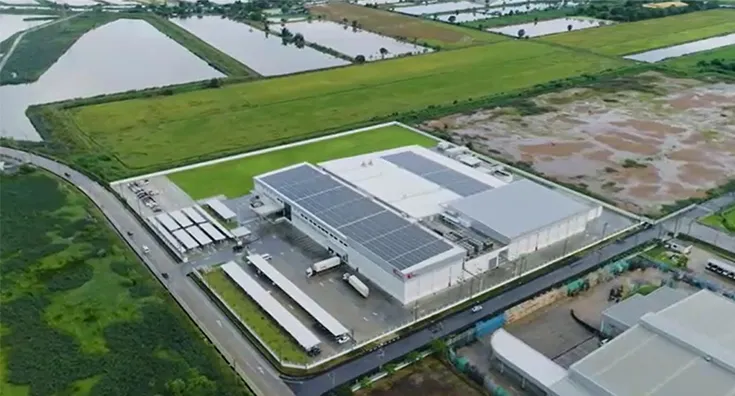
Solar Power Generation Facilities (Thai Delmar Co., Ltd.)
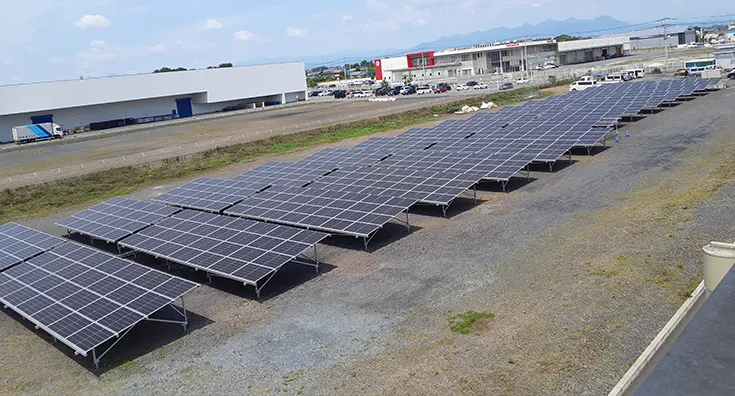
Solar Power Generation Facilities (Nippon Delica Service Co., Ltd., Isesaki Plant)
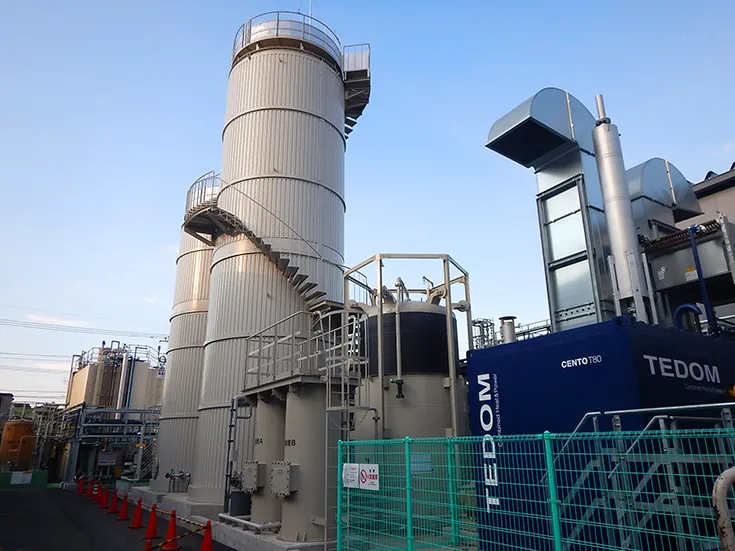
Fish Oil-Fueled Boiler (Fine Chemicals General Plant Kashima No.1 Plant)
Nissui’s Hachioji General Plant produces frozen foods, surimi-based products, and seasonings. In FY2018, the plant significantly enhanced its wastewater treatment system by introducing an anaerobic ozone treatment facility to complement the existing enzymatic wastewater treatment facility. However, the wastewater treatment process at this facility resulted in the production of methane gas, which has a much greater greenhouse effect than CO2. To counter this, Nissui embarked on a biomass electricity generation initiative, capturing the methane produced in the treatment process and using it to fuel power generators. This innovative step not only adds value to the wastewater treatment process, but also plays a critical role in preventing global warming by reducing methane emissions into the atmosphere. This proactive approach is expected to reduce methane emissions by an estimated 2,380 t-CO2 equivalent annually.
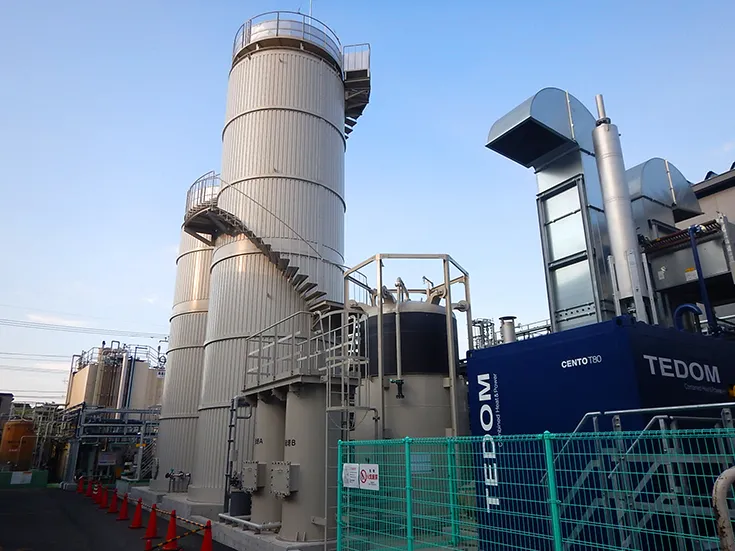
Biomass Electricity Generation at the Hachioji General Plant
The Nissui Group promotes the effective utilization of thermal energy generated during production processes. By recovering waste heat from production equipment and using it for purposes such as heating water supply, we aim to reduce overall energy consumption. We are also working to improve insulation by installing insulation jackets to suppress heat loss from equipment and piping.
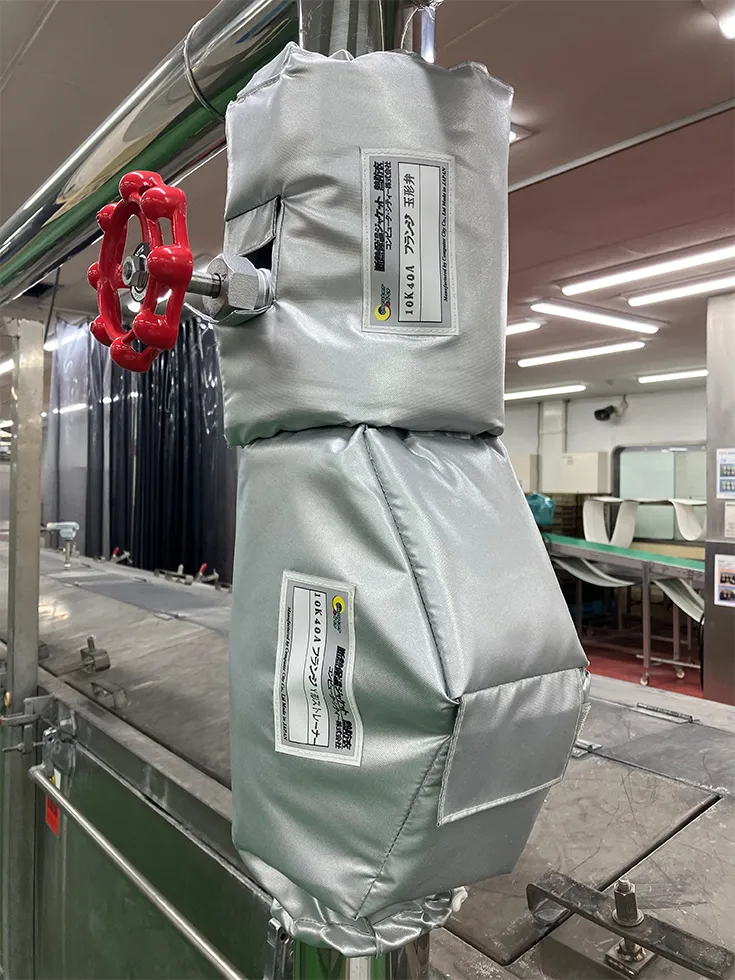
Improved Thermal Insulation Through the Use of Insulation Jackets
Carry Net Co., Ltd., which is one of the Nissui Group companies in Japan, is a transportation company with twelve sales offices (excluding the head office) across Japan. Its role is to deliver Nissui products to our business partners on a daily basis. Centering on frozen transport, Carry Net is capable of executing transportation adapted to all temperature zones such as cold and ambient temperatures. It not only performs deliveries in the respective local areas of its sales offices but also carries out wide-area transportation across Japan by utilizing its fleet of vehicles as well as networks based on its partnership with collaborating companies.
Carry Net is making efforts to reduce CO2 emissions by performing transportation utilizing ferries.
In FY2021, Carry Net’s modal shift plan between Kawasaki and Fukuoka was approved as a plan for advancement of integration and streamlining of distribution business under the provisions of the Act on Advancement of Integration and Streamlining of Distribution Business of the Ministry of Land, Infrastructure, Transport and Tourism. This plan involves shifting part of our truck transportation to marine transportation using RORO vessels (Note) that primarily transport cargo, operated by our partner MOL Ferry Co., Ltd. This enables us to reduce ground transportation distance from approx. 1,100 km to approx. 120 km and CO2 emissions by 71%. In addition, the time required for a driver to be on the road can be reduced by 87.4%.
| Section | Number of boarded vessel services subject to modal shift | CO2 emissions reduced (t-CO2) |
|---|---|---|
| Between Kansai and Fukuoka 460km | 1,753 | 1,987 |
| Between Kawasaki and Fukuoka 1,100km | 496 | 1,222 |
| Between Kanto and Kansai 510km | 682 | 683 |
| Others | 13 | 18 |
(Note) RORO vessels (Roll-on/Roll-off ship): A cargo ship with a deck for vehicles, designed to carry loaded trucks and trailers as they are.

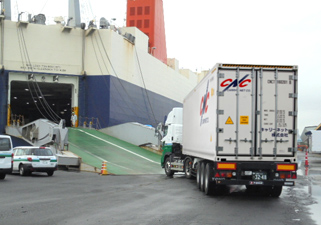
Specialized Carry Net Truck Boarding a MOL Ferry RORO Vessel
Carry Net executes mass transportation based on trailer transportation (Note 1) between frozen food plant depots. Carry Net also conducts switch operation (Note 2), which helps improve drivers' working environment as well.
(Note 1) Trailer transportation: Capable of loading approx. 1.3 times more cargo than large vehicles. Can load 40 sheet pallets.
(Note 2) Switch operation: Operation by switching the head and the trailer.
Double-deck trucks make it possible to realize diversified transportation through partitioning (e.g., frozen temperature in the front compartment and chilled or ambient temperature in the rear compartment), and optimize the inside of the vehicle according to customers' needs. For the transportation of products in different temperature zones, multiple vehicles had to be organized by temperature zone in the case of conventional trucks, whereas with double-deck trucks, the number of vehicles can be reduced by transporting them at once.
Ten large COOL Hybrid trucks (manufactured by Hino Motors) were introduced in June 2024. Electric energy is stored in batteries and converted into energy for refrigeration and driving, thereby reducing CO2 emissions from large vehicles.
Nissui has been promoting the introduction of hybrid vehicles, PHVs and EVs (Note) in its sales fleet in an effort to reduce CO2 emissions. Nissui's targets and results of the introduction of eco-cars as a percentage of its sales fleet are as follows.
(Note) PHV: Acronym for Plug-in Hybrid Vehicle. PHV is a hybrid vehicle that can be charged by using an external power source and has a large battery capacity. Even when charged by electricity alone, PHV is capable of traveling longer distances than conventional hybrid vehicles. EV: Acronym for Electric Vehicle.
| Indicators | Scope | Results | Target by 2024 |
Target by 2030 |
||
|---|---|---|---|---|---|---|
| FY2022 | FY2023 | FY2024 | ||||
| Introduction of hybrid vehicles | Nissui Corporation | 93.0% | 95.1% | 95.5% | 100.0% | 100.0% |
| Introduction of PHVs/EVs | - | 1.0% | 0.5% | - | 10.0% | |
Scope: Nissui Corporation
The “Development and Field Testing of an Aquaculture Feed Boat Using Hydrogen Fuel Cells for Use in Fish-farming” project, in which Nissui Group company Kurose Suisan Co., Ltd. has been participating, has been chosen by Japan’s Fisheries Agency as an “Aquaculture Synergy Business Creation Project.” This project has been undertaken by a consortium of three participants: the Fishing Boat and System Engineering Association of Japan (acting as project lead), the Japan Fisheries Research and Education Agency (FRA), and Kurose Suisan. To promote the transition toward carbon-neutral aquaculture that will be both a high-growth industry and decarbonized, the project aims to bring about a switch away from using fossil fuels to power the feed boats used in aquaculture, toward using non-fossil fuel power sources such as hydrogen, through the development, building and field testing of a feed boat equipped with hydrogen fuel cells. This represents an important initiative in terms of building a sustainable fisheries sector in which greenhouse gas emissions from boats are reduced, and the Nissui Group will continue to proactively undertake development of this type of new technology in the future.
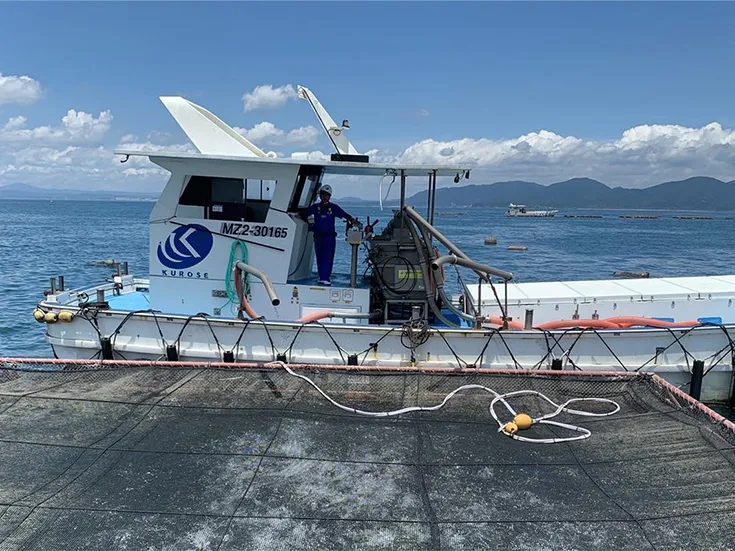
The Type of Feed Boat That Is Currently in Use
Nissui has been making group-wide efforts to review the use of refrigerants. Besides setting a target of reducing the use of CFCs and HCFCs to zero by FY2030, Nissui has also adopted a policy of ensuring that, for the main types of freezing and refrigeration equipment used by Nissui itself, 100% of newly-adopted equipment will use only natural refrigerants. Some examples of these, such as replacement with natural refrigerants utilizing government subsidized projects and new introduction of natural refrigerants, are as follows.
| Number of introduced cases | Example of introducing business location | Example of subsidy name | Example of natural refrigerant type | CO2 emissions reduced (t-CO2) |
|
|---|---|---|---|---|---|
| FY2022 | 3 cases | Nissui Logistics Corporation, etc. |
Reiwa 4th fiscal year Subsidies for CO2 Emission Reduction Countermeasures Projects "Project to Accelerate Introduction of Energy-saving Natural Refrigerant Equipment for Early Realization of HFC-free/Low Carbon Society" |
CO2/NH3 | 344 |
| FY2023 | 3 cases | Nissui Logistics Corporation, etc. | Reiwa 5th fiscal year Subsidies for CO2 Emission Reduction Countermeasures Projects "Project to Accelerate Introduction of Energy-saving Natural Refrigerant Equipment for Early Realization of HFC-free/Low Carbon Society" |
CO2/NH3 | 719 |
| FY2024 | 2 cases | Nissui Logistics Corporation, etc. | Reiwa 6th fiscal year Subsidies for CO2 Emission Reduction Countermeasures Projects "Project to Accelerate Introduction of Energy-saving Natural Refrigerant Equipment for Early Realization of HFC-free/Low Carbon Society" |
CO2/NH3 | 428 |